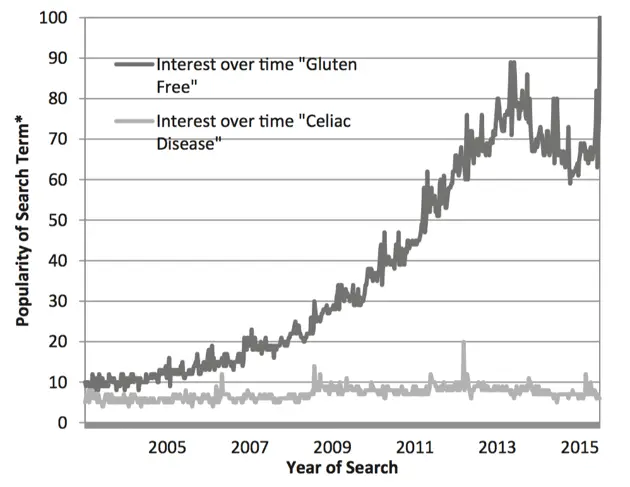The Celiac-Disease Awareness Month-May would be unnecessary if the excessively large amount of “gluten-free” advertisements and labels were any demonstration of the awareness of this disease. According to Norelle Rizkalla Reilly, a gastroenterologist who directs the pediatric program of the Celiac Disease Center at Columbia University, this is definitely not the case.
Her belief in the nationwide misconception derives not only from the everyday immersion in the world related to gluten immune disorder but also from a detailed analysis of our Google histories.
The Atlantic published her chart given below, on Friday:
“Celiac Disease” Versus “Gluten Free” – Google Search Term Popularity
As Reilly explains, the chart clearly illustrates the increasing trend of the popularity of this diet, which is completely out of proportion to any implication of celiac disease awareness.
Her practice has a careful basis and contemplates gluten-free diet implementation so the thought that therapy slips out of its important medical context has been concerning her. Celiac disease patients ought to avoid gluten. With proper and careful treatment, the small intestine lining will return to normal so a person can lose all of its symptoms.
This medical intervention hasn’t been proven to be beneficial for people without the disease, which is actually the case with most medical interventions. About 1% of people are said to be affected by Celiac disease, but according to a last year’s worldwide study which involved 30,000 people, 21% stated that they are seriously taking “gluten-free” into consideration, regarding their food choice. The number among Millennials is near one in three. People from both, upper and middle-class households, and from all levels of education are avoiding gluten mostly in The Atlantic.
Reilly explains that people need to be properly and accurately informed about the gluten-free diet.
She points out the risks of practicing a gluten-free diet without any medical reasons. According to many studies, people who turned to a gluten-free diet showed raised metabolic syndrome rates, probably because of the low nutritional content of gluten-free replica foods. Moreover, as other studies show, people can also develop iron, thiamine, and folate deficiency, which are included in grain products.
Spanish researchers made a comparison of 206 gluten-free foods and their counterparts (those including gluten), and have discovered significant differences in their caloric and nutrient contents. Celiac patients may be concerned by this nutritional fact, but also non-celiac people who follow a gluten-free diet.
Reilly explains that grain products are replaced with rice by many gluten-free products, which is known as “secret rice”, and since a lot of parents are concerned about their kids being exposed to arsenic from rice, the best option will be to give them a diverse diet. However, this goal is further hardened with the attempt to get rid of all foods with gluten in their content.
She points out that people of all ages have been shown to have worsened life quality after the switch, which was actually proven by some studies. A gluten-free diet can especially affect children’s life in terms of social interactions. Children with this disease went to a gluten-free camp for a week period, where every food was gluten-free. During this period they showed improvement in self-perception, well-being, and emotional outlook probably because the surrounding reduced the anxiety and stress around the social interactions and food.
However, real life is not a gluten-free camp, and the prices of these products are often more expensive than the traditional ones.
Reilly continued to say that there’s a big number of patients who need to be on this type of diet, but many others who are on a gluten-free diet without any particular reason, or because of an assumption that they might have celiac disease but without doing any tests. People have obviously mistaken “gluten-free” for “healthy. Proper diagnosis is needed not only for avoiding unnecessary gluten-free foods in your diet, as well as its risks and pricey costs, but also since sometimes other conditions can go simultaneously with celiac diseases, such as anemia, liver disease, dermatitis herpetiformis, osteopenia, and lymphoma. The correct diagnosis will inform the patients for their proper medical care, as well as their family members.
Reilley advises avoiding anything that could possibly cause the detection of celiac disease, and this includes beginning a gluten-free diet on your own.
Via The Atlantic
